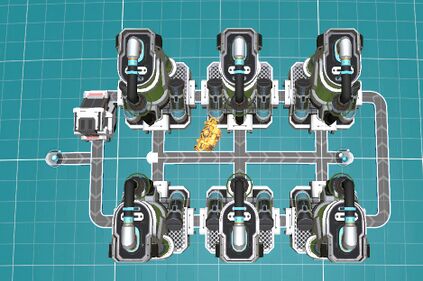Summary
The Fractionator is a unique facility with 3 Conveyor Belt ports. The input requires Hydrogen, belted in from one side, and leaving through its opposing belt port. 1% of the Hydrogen passing it will be converted into Deuterium, which needs to be belted out from the middle port.
Since the total production of the Fractionator directly scales with the amount of Hydrogen passing through, much higher production rates will be achieved when the belt itself is faster and/or stacked.
Fractionators will conserve Hydrogen stacks that are passing through, with the exception of converted Hydrogen, which is removed from the stack. Hydrogen is converted individually and not per stack, so any singular Hydrogen has the same chance to be converted.
Production Chain
Production Progression Chart
Math and Layout
- The Fractionator is unique since the amount of Deuterium produced is a percentage of the Hydrogen input. This means that the rate of Deuterium conversion is directly proportional to the Conveyor Belt's speed (1% of belt speed), how saturated the Hydrogen input and outputs are, and how high the Hydrogen input is stacked.
[Belt Speed] * [Stack Size] * ([Initial Saturation Percentage] - (0.99 ^ [Number of Fractionators])) = [Total Deuterium Production Rate]- Production rates for a single fractionator with fully saturated input belt:
| Conveyor Belt | Stack Size 1 | Stack Size 2 | Stack Size 3 | Stack Size 4 | ||||
|---|---|---|---|---|---|---|---|---|
| 3.6/m | 0.06/s | 7.2/m | 0.12/s | 10.8/m | 0.18/s | 14.4/m | 0.24/s | |
| 7.2/m | 0.12/s | 14.4/m | 0.24/s | 21.6/m | 0.36/s | 28.8/m | 0.48/s | |
| 18/m | 0.3/s | 36/m | 0.6/s | 54/m | 0.9/s | 72/m | 1.2/s | |

- It is useful to build Fractionators in a conveyor loop, with one entry point for Hydrogen. This allows cycling of Hydrogen already on the belt for further conversion to Deuterium, requiring only the replacement of Hydrogen that was converted. However, limiting the loop size or replenishing Hydrogen in between is crucial since every converted Hydrogen will lower the efficiency of each following fractionator in line.
- This equation gives the expected total production of a 100 Fractionator setup on a non stacked Conveyor Belt Mk.III loop, starting at 100% saturation as
30 * 1 * (100% - (0.99 ^ 100) = 19.019 Deuterium/second, or a system conversion rate of 63.4%. In comparison, a loop of 6 Fractionators will operate at 94,14% conversion efficiency.
- As a result, having multiple entry points in the conveyor loop for Hydrogen to replenish saturation, or multiple conveyor loops is recommended. With the introduction of Piler Sorters 100% efficiency can be ensured by re-stacking the Hydrogen loop in between each Fractionator, rendering the traditional single-loop setups obsolete. Thus, Piler Sorters also remove the need for limited loop size.
- In order to prevent clogging of the loop setup (circulation ceases) the Hydrogen inflow conveyor must be joined to the conveyor loop via T-Junction or via Splitter with the returning Hydrogen input set as prioritized. Alternatively, the Hydrogen can be injected via sorters.
- Proliferating Hydrogen increases the Fractionator's conversion rate by the Proliferator's Production Speedup bonus, also applying the energy consumption penalty. Passing through the Fractionator does not remove the Proliferator marks from the Hydrogen unless it gets converted.
- The energy consumption of a Fractionator depends on the Deuterium output (or equivalently the Hydrogen Input) for Deuterium output rates below or equal to 18/m (full Mk. III Belt with Stack Size 1) the base energy consumption of 720 kW is independent of the output rate as long as it is non-zero. For Deuterium output rates above 18/min the energy consumption is given by 0.06*([Deuterium/m]-6) MW. For example a Fractionator running on a fully stacked Mk. III Belt with 72 Deuterium/m consumes 3.96 MW. When using Proliferators for Production Speedup bonus the energy consumption rate is increased as usual (20%, 70% and 150% increase when using Mk. I, II., or III. Proliferator respectively). Thus the maximal energy consumption of a single Fractionator is 9.9 MW while producing 144 Deuterium/m on a fully stacked Mk. III belt of Mk. III proliferated Hydrogen.
- Max throughput for a line of N Fractionators processing 7200 stacked, proliferated Hydrogen/minute is 7200 * (1 - 0.98 ^ N). 14 Fractionators in a line will yield an average 1773 Deuterium / minute, not quite saturating an output belt. Alternately 2 lines of 6 fractionators on either side of a single output belt will yield 1643/m.


















































































































































































